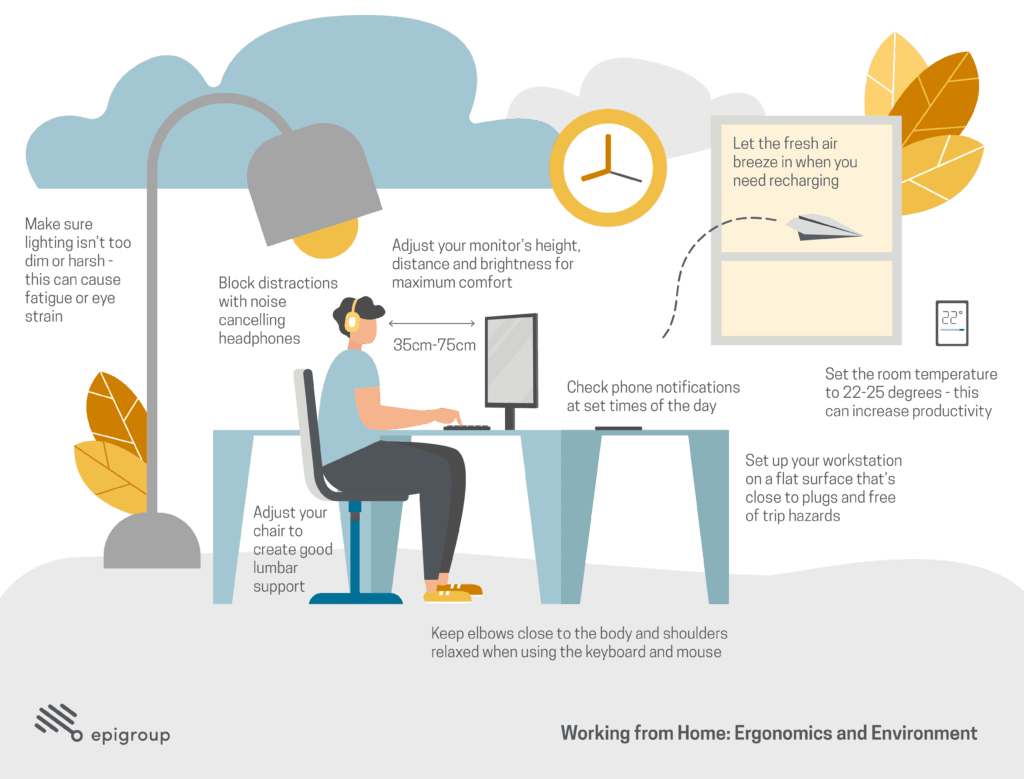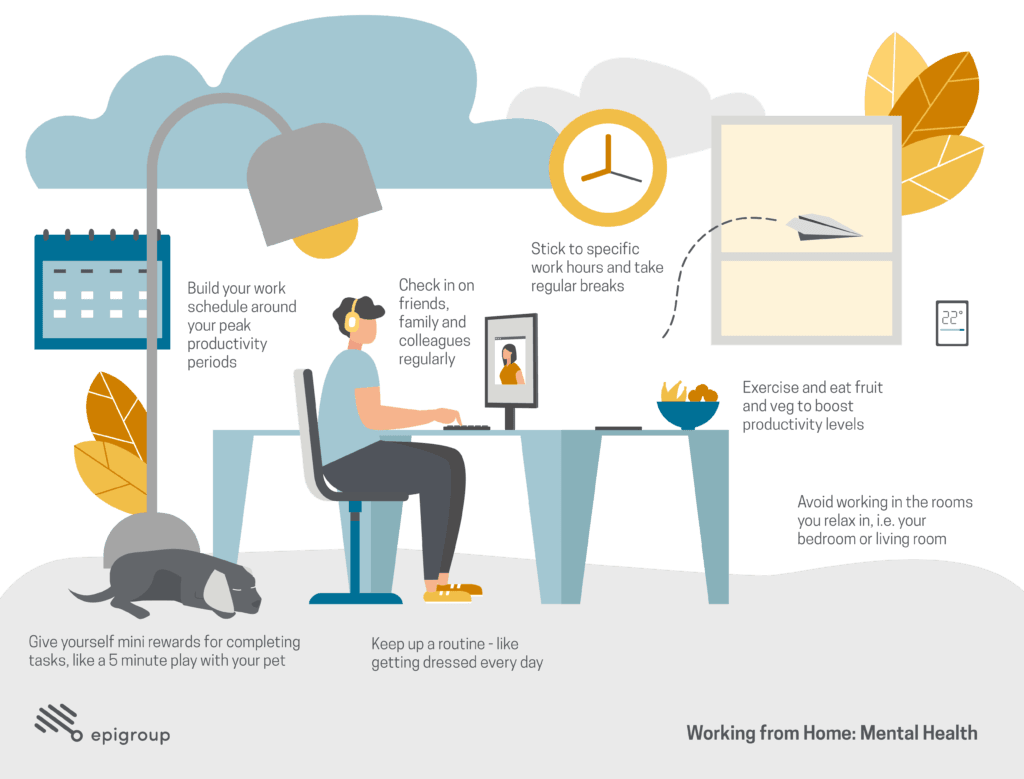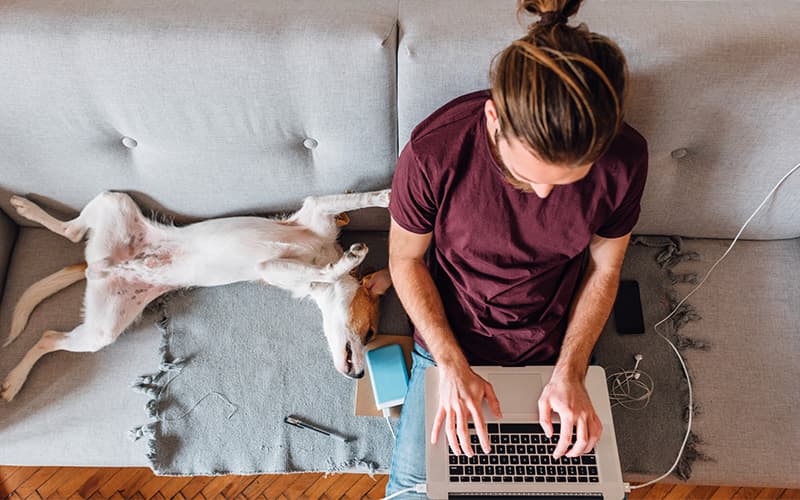When your manager says that long-awaited phrase “you should work from home,” what fantasy plays out in your head?
Do you have your feet up on the sofa, slippers on, one hand on your laptop the other on your doggo’s little head? Perhaps you’re in your PJs, propped up in bed reading paperwork surrounded by toast crumbs (we’ve all been there). Or are you locked away in your home office with jazz music muffling the sound of your kids stampeding through the house?
While they all sound pretty ideal, they’re not the best working environments for your physical or mental health – especially in the long run.
Australian employers have a legal duty of care and must make sure their staff’s health and safety will not be compromised when working from home.
In fact, in non-COVID-19 situations, employers can even visit your home to check for things like trip hazards and broken cords.
Working from home is the norm for many people, so let’s look at some working from home tips to keep you physically and mentally healthy.
Prefer ‘doing’ than reading? Take our FREE working from home online course.
Ergonomics
Let’s go back to the sofa scenario. Avert your gaze from your dog’s adorable face for a moment and take a look at your posture.
Are you sitting upright? Do you have back support? The answer is probably no.
Last year the Australian Institute of Health and Welfare found 1 in 6 Aussies had back problems in 2017-18. When working from home, your posture and workstation can either make or break those regular visits to the physio or chiro.
You might be fully set up with a sit-stand desk and ergonomic chair. Then again, you might have had this situation thrust upon you and have to make do with what you already have – like a dining table and chair.
Here are some tips to help you set up for success.

Desk
When you go camping, you don’t just stick your tent anywhere, do you? You look for a flat, clear, sturdy spot that’s close to power and water. Well, your workstation is just like that.
Choose somewhere that’s level, close to plug sockets and free of trip hazards like cords and rugs.
Chair
If you’re working from home long term, it’s wise to order a desk chair (tax deductable!) or borrow one from the office.
Your chair’s height is key for keeping your knees and elbows at right angles, which will prevent aches and pain. Adjusting all parts of your chair for adequate support is also super important, which you can learn all about here.
If you do fancy mixing things up, you can use a gym ball for periods of time. Just make sure it’s the right height for you and your desk.
Monitor
Research prepared for OPSM shows office workers spend an average of 11.4 hours in front of a screen every day. This can really take its toll on our eyes, but there are several things we can do to alleviate eye strain.
First, you should sit 350mm – 750mm away from your screen.
Next, avoid any glare on the screen like a window, light reflection or grubby fingerprints. This can make it hard to focus.
Make sure the screen isn’t too bright. As a rule of thumb, it should match the room lighting and shouldn’t cause any discomfort.
Lastly, make sure the top of your monitor is at or slightly lower than eye level to protect your neck.
Keyboard and Mouse
Make sure everything you use often is in easy reach, especially your keyboard and mouse.
When using your keyboard and mouse, make sure you’re not extending your arms too far outwards. Keep your elbows close to your body and shoulders relaxed to avoid aches and pains. Your keyboard should also be directly (and symmetrically) in front of your monitor.
RELATED: Reopening a Business After COVID-19: A Health & Safety Checklist
Environment
Working from home is full of distractions. It can be hard to kick goals and smash out some work, especially with a toddler kicking your chair and smashing everything else.
Research has shown it can take almost 25 minutes to get back on track after a distraction, so here are a few tips to help you stay in the zone:
Notifications
When the group chat is lit with the latest fake news or quarantine meme, it’s tough to get things done.
Research from Duke University found the average person gets a whopping 65 – 80 notifications per day. Social media is about to get a whole lot nosier with an influx of people working from home, in quarantine or unemployed. So we can expect the notifications to increase.
While turning them off may seem like the easy solution, the study also found that this created FOMO and people checked their phones more.
Instead, try setting specific times in the working day to check your notifications, for example 9am, 1pm and 5pm.
Noise
There are two types of people in life: those who can work with music on and those who can’t.
If you need to play that funky music, noise cancelling headphones are a worthwhile investment for work, play and sometimes – just quietly – relationships.
If the sound of a pin dropping is enough to finish your day, set up in a quiet part of your home and try wearing noise cancelling headphones without music or earplugs.
Lighting
Which desks are the first ones to get claimed in the office? It’s the ones next the windows, right?
Not only can windows provide great views, but research has consistently showed that sunlight has positive effects on our wellbeing.
However, natural light is also inconsistent. It alters throughout the day and throughout the seasons, so we can’t rely on it all the time.
This is where artificial lighting comes in. Multiple studies have found artificial lighting can offer a tonne of benefits like visual comfort and improved performance (read more about that here). But it’s not without its faults either, as dimly lit or harsh lighting can cause fatigue or eye strain.
In short, if your eyes are uncomfortable or you feel tired, adjust the brightness or colour of your lights and make sure the space is illuminated evenly with little contrast and glare.
Lamps are also handy for focus-intensive tasks.
Ventilation and temperature
Every office has a person that insists on working in sub-zero conditions. As well as chilling you to the core, this person may also be reducing your productivity.
Now that you’re in charge of the thermostat, make sure you can adjust the temperature to suit you. A Cornell University study found employees working at 20 degrees made 44 per cent more mistakes. Similarly, temperatures too warm can lead to slow, sleepy minds, so flick on a fan if you need perking up.
A different study found the ideal temperature is 22 degrees. Try starting there and adjust accordingly to suit your concentration levels.
And don’t forget to crack a window from time to time. Fresh air blows a tonne of health benefits our way, including helping our immune systems, lungs, energy levels and brain power – four things we need in tip-top shape right now.
Plus it’s great for your mental health, which brings us to our final focus of working from home…
RELATED: 6 Health and Safety Trends to Prepare for in 2020
Mental Health
Now that you’ve got some snazzy new gear and your workstation is oozing positive Feng Shui, the rest is up to you. All the physical equipment in the world isn’t going to help if you don’t have the right mentality.
Working from home can have a huge impact on your mental health, whether that’s for good or for bad.
Sometimes that stems from the reason you’re working from home in the first place. Starting your own online business so that you can stay home with the kids is a really positive scenario, and far from the morbid circumstances we’re all going though at the moment.
Isolation, lack of motivation, stress and loneliness (which has a similar influence as smoking cigarettes) are normal feelings to experience when working from home, but there are things you can do to curb them…

Set boundaries
When you work from home, the boundaries between your work life and homelife start to blend. Your home is your haven and suddenly your work is always there, staring at you from across the dinner table. So how do you switch off?
Right now, in our isolated little lives, the only way we can physically get away from our work is by using a different room. If you can, dedicate a room to work in away from where you relax – i.e. not in your bedroom or living room.
Establish routine
The beauty of working from home is that you can be flexible when setting your hours. For example, if you’re most productive in the morning or you need to get the kids from school, you may want to set your work hours from 7am until 3pm.
Enforce a hard limit at the end of the day and when you get there, pack up and back up from your desk to avoid working around the clock.
Although it’s tempting to live in your pjs, keeping up parts of your old work routine – like a morning workout, getting dressed and making your lunch the night before – can really help.
Create rewards
Do you love treating yourself? Of course you do. Try setting mini rewards for completing tasks to keep your morale and productivity going.
For example, you could reward yourself with a coffee, a five-minute play with your pet or a stroll around the garden.
Stay physically healthy
When you work from home, you have a VIP pass to your kitchen. When you’re feeling peckish, it’s easy to gravitate to the convenient unhealthy snacks like chips, cookies or leftover pizza. No one is around to judge you and you don’t have to save any for your colleagues. It’s all yours for the taking. No one will ever know.
But snap out of it because research has shown that eating fruits and vegetables has a direct link on overall productivity levels.
Make healthy eating easy for yourself by only buying nutritional food and in advance, rather than buying on impulse. A bit of prep can go a long way too. Try keeping fruit on your desk or chopped veg in the fridge ready to go with your favourite dip. It will help stop your wandering hands caressing the biscuit jar.
Exercise can also go out the window when you’re confined to your home or if you don’t set start and finish times. Exercise naturally boosts endorphins, which increases happiness and interest levels, all of which are important for productivity.
Regularly stretching helps you maintain great posture, so as a bare minimum, stretch throughout the day so that you don’t get sore.
Socialise
Yes, things are bad now, but they could be a lot worse and far lonelier. We’re really lucky in our current situation to have technology to help us stay connected. Zoom meetings, FaceTime and group chats are just a handful of ways you can keep conversations going with colleagues, friends and family
If you or someone you know struggles with depression, working from home may aggravate feelings of isolation. Be sure to check in more regularly on those who are vulnerable, or if you’re having those feelings yourself please reach out to a friend, colleague, family member or a helpline such as Beyond Blue or Lifeline.
We hope this has given you some good tips to help you create a safe and healthy work environment. Working from home comes with many challenges, but we’re all in this together.
Want to take our online working from home course? Head to Epigroup’s e-Learning Store to learn more.


